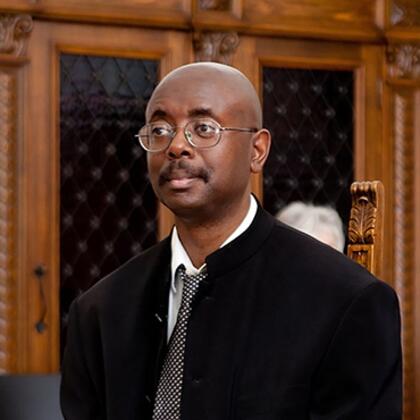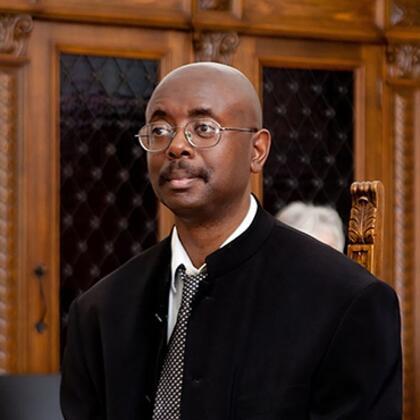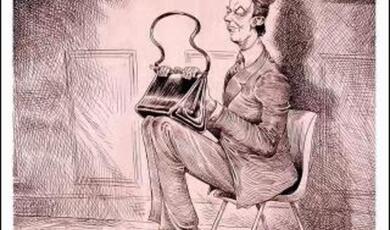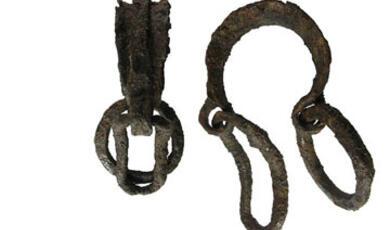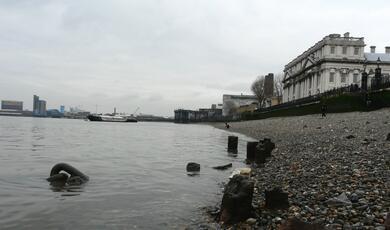The Manuscripts and Intellectual Legacy of Timbuktu
Share
- Details
- Transcript
- Audio
- Downloads
- Extra Reading
The Malian city of Timbuktu is one of the world's oldest seats of learning and has an intellectual legacy of hundreds of thousands of manuscripts, coming from three great West African desert empires: Ancient Ghana, medieval Mali, and the Songhai Empire. These manuscripts offer a unique window into their history. Many remain unread.
This lecture will look at how their study can be used to advance our knowledge of the intellectual history of the premodern world.
This lecture is also part of the 'Books, Libraries and Civilisation' series which can be found here.
Download Transcript
My Early Research
- Role of Professor Chancellor Williams, The Destruction of Black Civilization, US, Third World Press, 1987, p.207
- “In the Muslim destruction of the Songhay empire, the main centres of learning with all of their precious libraries and original manuscripts were destroyed first”
- Role of Professor Cheikh Anta Diop, Precolonial Black Africa, US, Lawrence Hill Books, 1987, p.182
- “[The loss of] the judicial and administrative archives: assistants of cadis kept minutes of the sessions. But tons of documents have disappeared”
- Influenced by Williams and Diop, most Black scholars believe that West Africa’s intellectual heritage was mostly destroyed after 1591
- This is STILL the mainstream view among Black scholars
Forcing a Paradigm Shift
- Role of Professor Henry Louis Gates, Into Africa (television programme), UK, BBC Television, 1999
- Jeremy Issacs ed., Millennium 1300-1400 (television programme), UK, BBC Television, 1999
- John Snow & Ekow Eshun, Living on the Line (television programme), UK, Channel 4 Television, 1999
- Aminatta Forma, The Lost Libraries of Timbuktu (television programme), UK, BBC Television, 2009
- Also National Geographic and News at Ten
What Has Survived?
- Black families in Timbuktu still own around 60 private libraries today
- These family collections have survived political turbulence and climatic fluctuations
- However, despite floods, fire, insects, pillaging and plunder … (wait for it)
- 1 million manuscripts may have survived “dispersed throughout the region from the shores of the Mediterranean to the northern fringes of the forest regions of Guinea and Ghana” say Hunwick & Boye
As an Example
- Moctar Sidi Yahia al-Wangari is the director of a 16th century Timbuktu library owned by his ancestor
- The books originally belonged to the 16th scholar Professor Muhammad Baghayogho al-Wangari
To Give Some Details
- The Ahmed Baba Institute in Timbuktu was established in 1970
- It was named after Professor Ahmed Baba, once a student of Professor Muhammad Baghayogho al-Wangari
- It has nearly 30,000 manuscripts that are being studied, catalogued and conserved
- However, during the colonial era many manuscripts were seized and burned
- Following droughts, many people buried their manuscripts and fled
- Many families still refuse access to researchers for fear that the pillaging of the colonial era will be repeated
Why Wasn’t All This Recognised Before?
- In 1894 France conquered Timbuktu
- During the colonial period some owners of manuscripts hid them away and sometimes buried them
- They feared the French colonial power would seize them
- It is only within the last 30 years that the intellectual life of this region has revisited the sun
- During the colonial period French was imposed as the main language
- Many manuscript owning families lost the ability to read and interpret them
This Session
- Overview of West African history
- Timbuktu in the Age of the Mali Empire
- Timbuktu in the Age of the Songhai Empire
- University life
- The literature itself
- The 2008 South African-Mali Project
Theme One: Overview of West African history
Overview of West African history
- Role of Abdurrahman Al Sadi, Tarikh Al Sudan, 1656
- “I saw the ruin and collapse of the science of history. I observed that its gold and small change were both disappearing”
- He divided the history into the three empires of
- Ghana
- Mali
- Songhai
Where Were These Empires?
- Ancient Ghana
- The Geography of the Ancient Ghana Empire at its height in the 10th and 11th centuries
- Role of the two rivers
- Size of the empire
- Arab conquest against North Africa (639-708 AD)
- “At the time of the conquest of Northern Africa [by the Arabs between 639 and 708 AD], some merchants penetrated into the western part of the land of the Blacks and found among them no king more powerful than the king of Ghana. His states extended westwards to the shores of the Atlantic Ocean … [Kumbi-Saleh], the capital of this strong, populous nation, was made up of two towns ... and formed one of the greatest and best populated cities in the world”
- Ibn Khaldun, The Philosophy of History, 1394
- Impact of the Arabs
- Role of Islam in African culture – a rival for Traditionalism or Ancestralism
- The conquest of North Africa and the migrations
- Role of Dahia al-Kahina
- Islamic Sources of African History – such as Ibn Haukal, Surat al-Ard, 951
- Relations Bween the City State of Audoghast and Other Kings
- “[The] king of Audoghast maintains relations with the king of Ghana. [The ruler of] Ghana is the richest king on the face of the earth by reason of the wealth and treasure of nuggets dug up in the past by his predecessors and by himself. He exchanges presents with the ruler of Kugha whose wealth and prosperity is nothing like that enjoyed by the ruler of Ghana”
- Ibn Haukal, Surat al-Ard, 951
- Birth of Timbuktu
- Timbuktu was founded during the dominance of the Ghana Empire
- Sanhaja desert nomads founded it around 1100 AD
- Typically they camped near the river in the dry season and took their animals to graze in the inland territories during the rainy season
- While the nomads were away they entrusted their belongings with their slaves, one of whom was called Buktu
- The campsite was thus calls Tim (i.e. well of) Buktu
- What began as a semi-permanent nomadic settlement evolved into a town and then a city of permanent settlement
- From 1100 to 1300 the city developed into a thriving commercial centre
The Role of Trade
- Timbuktu became a centre of commercial exchange between Saharan Africa, Tropical Africa and Mediterranean Africa
- Acting as a magnet, it attracted men of learning and men of commerce
- Timbuktu benefited from the gold trade coming from the southern reaches of West Africa
- It benefited from the salt trade coming from the Sahara Desert
- Approximately two thirds of the world’s gold came from West Africa in the 14th century
- The Products
- Textiles, tea, and tobacco were imported into this region
- Based on the number of poems about tea found among the manuscripts of Timbuktu, this was an extremely cherished item
- Tobacco had even been approved in a treatise by Timbuktu professor Ahmed Baba, On the lawfulness of tobacco usage, who claimed it was neither a narcotic nor an intoxicant!
- The most profitable trade item in Timbuktu was books. The Tarikh al Fettash says that the King bought a great dictionary for the equivalent price of two horses
- Buying books was a socially accepted way of displaying wealth and a source of prestige
Theme Two: Timbuktu in the Age of the Mali Empire
Birth of the Malian Empire
- Role of the Mandingas and their capital city – Niani
- Role of Sundiata Keita – He conquered Ancient Ghana in 1240
- Role of Mansa Musa – He built the Malian Empire (1312-1337)
- Role of Islam as the religion of the cities
- Arabic became the language of scholarship
- Trade based on gold, salt and copper (from Takedda)
The Role of Arabic
- Arabic could be described as ‘the Latin of Africa’
- It was useful when communicating between the different peoples – Songhai, Fulani, Tuareg, Bambara, Mossi, Hausa
- Just as Latin became an important language in mediaeval Europe associated with Christianity, Arabic became an important language in Africa associated with Islam
- Just as Europeans adopted the Latin script to write their own languages, Africans used the Arabic script to write their own languages
Geography of Malian Empire at its height in the 14th century
- The wealth of Mali
- “In the fourteenth century, the century of the scythe, natural disasters threatened civilisations with extinction. The Black Death kills more people in Europe, Asia and North Africa than any catastrophe has before. Civilisations which avoid the plague, thrive. In West Africa the Empire of Mali becomes the richest in the world”
- BBC, Millennium: One Thousand Years of History, 1999
- What did they spend the money on?
- The Sankore University mosque was built around 1300 (or earlier) with funding from a woman of the Aghlal, a religious Tuareg ethnicity
- The Sankore quarter in north-east Timbuktu became the dwelling place of the scholars and teachers it was here that the first libraries were created
- Scholars and kings acquired books during their travels and from merchants coming from the north with books for sale
- Mansa Musa bought works on Maliki law and ordered the construction of the Great Mosque of Timbuktu
The Great Mosque of Timbuktu, 1326
- Challenges to Malian hegemony
- In 1343 the Mossi attacked Timbuktu
- A source says: “The Mossi sultan entered Timbuktu, and sacked and burned it, killing many persons and looting it before returning to his land”
- Timbuktu however recovered and the Malians continued to rule it for 100 years
- However: “The Tuaregs began to raid and cause havoc on all sides. The Malians, bewildered by their many depredations, refused to make a stand against them”
- Mali lost control of Timbuktu in 1433
Theme Three: Timbuktu in the Age of the Songhai Empire
The Birth of the Songhai Empire
- The Songhai were once tributary to Mali but became independent as Mali declined
- Role of Sunni Ali Ber (1464-1492) – He conquered most of the Songhai Empire
- He seized Timbuktu in 1469
- We read: he “perpetuated terrible wickedness in the city, putting it to flame, sacking it, and killing large numbers of people”
- The gold traders feared Sunni Ali would take control over their goods and transactions so many started trading via the Hausa city state of Kano in northern Nigeria
- The scholars of Timbuktu experienced a major setback
- Sunni Ali drove the Sanhaja out of Timbuktu and undertook a purge of the scholars – Many fled to Walata
- Subsequent rulers
- Subsequent rulers of the Askiya Dynasty adopted a more conciliatory approach towards the scholars
- They offered them cash and in-kind – especially during Ramadan, including slaves, grants of land and privileges, and exemptions from taxation
- Why slaves?
- Major Dubois says: “[T]o ensure them the tranquillity so necessary to a man of thought and letters, their affairs were managed and their properties cultivated by their slaves”
- Timbuktu under the Askiya Dynasty (1493-1591)
- Timbuktu benefited under the reign of the Askiya Dynasty
- This is what that Tarikh al Fettash says:
- “One cannot count either the virtues or the qualities of [Askiya Muhammad], such is his excellent politics, his kindness towards his subjects and his solicitude towards the poor. One cannot find his equal either among those who preceded him, nor those who followed. He had a great affection for the scholars, saints and men of learning”
- However, role of Islam (in the cities) and Traditionalism (in the villages) – in other words the villagers did not benefit from the Askiya Dynasty
Geography of the Songhai Empire at its height in the 16th century
- Timbuktu rises to intellectual dominance
- Walata ‘where the holiest and most learned men resided’ and Djenne were centres of Islamic scholarship in the early days
- According to Chu & Skinner:
- “Learning flourished within Jenne [sic]. It had a university of very high reputation. The university boasted of having thousands of teachers … There were reports of several different surgical operations successfully performed by the medical doctors of Jenne”
- E.g. eye cataract surgery
- Timbuktu surpassed both of them after 1500
International scholarly connections
- Its scholars and students came from the entire region also including Saharan and Mediterranean Africa
- There were scholarly connections between Timbuktu and Fez
- North Africa and Andalusian scholars visited and settled in and around Timbuktu
- Connections were made with fellow scholars in Egypt and Mecca during pilgrimages
- What Was Life Like in Timbuktu?
- According to the Tarikh al Fettash
- “Timbuktu has no equal among the cities of the blacks ... and was known for its solid institutions, political liberties, purity of morals, security of its people and their goods, compassion towards the poor and strangers, as well as courtesy and generosity towards students and scholars”
- What did anyone else think?
- According to Leo Africanus in A History and Description of Africa, c.1526
- “The people of Timbuctoo have a light-hearted nature. It is their habit to wander into town at night between 10 pm and 1 am, playing instruments and dancing”
- “In Timbuctoo there are numerous judges, doctors [i.e. of letters], and clerics, all receiving good salaries from the king. He pays great respect to men of learning. There is a big demand for books in manuscript, imported from Barbary [i.e. North Africa]. More profit is made from the book trade than any other line of business”
- A Religious City
- A West African proverb says:
- “Salt comes from the north, gold from the south and silver from the country of the white men, but the word of God and the treasures of wisdom are only to be found in Timbuktu”
- There is a local legend that Timbuktu is surrounded and protected by 333 renowned saints as well as numerous lesser saints
- Surrounding the city like a rampart were chapels where these saints were buried
- According to the Sufis a wali or saint is a Muslim mystic usually a scholar who has achieved such closeness to God as to possess special powers or baraka
- For example, we read: “The very learned and pious sheikh, Abou Abdallah, had no property, and he bought slaves that he might give them their liberty. His house had no door, every one entered unannounced, and men came to see him from all parts and at all hours”
Theme Four: University life
University Life
- The Sankore mosque was the main teaching venue – many scholars lived in the Sankore quarter
- Classes were also taught at the Great Mosque and the Oratory of Sidi Yahya
- Most of the teaching took place in the scholar’s houses where each scholar had his own private library which he could consult when knotty points arose
- Very often a student would study under six or seven different tutors, one for each subject
- At the height of the Songhai empire, Timbuktu had 25,000 students
The Oratory of Sidi Yahya
- Student Fees
- The students would pay the teachers and lecturers in money, clothing, poultry, cows, sheep, or services, depending upon how well off the student’s family was
- According to the Tarikh al Fettash, Timbuktu had 26 textile factories where each master tailor employed 50 to 100 apprentices
- Enrolment was restricted to students at a certain level of education
- Working in the tailoring industry secured students an income enabled them to further their studies
Teaching Techniques
- The teachers were experts in a number of texts – This is not quite the same as being an expert in a subject
- The traditional teaching method involved the lecturer dictating a text. The students would write their own copies and would read back to the teacher what they had written down. All the students would do the same. In this way, students would learn from each other’s mistakes. Once the correct version has been written down, the lecturer would explain the technical intricacies of the text and engage in a higher level of discussion
Teaching and Learning
- Treatises on pedagogy have survived in the manuscript collections of Timbuktu
- Some of these books wrote about how to learn to read, how to improve memory, suggestions on what subject matter should be taught, and the descriptions of the ideal teacher
- However, an ideal students is:
- “modest, courageous, patient and studious; he must listen carefully to his professor and have a solid understanding of his lessons before memorising them. The students must learn to debate between themselves to deepen their understanding of the material. They must always have a great respect and a profound love for their teacher, because these are the conditions for professional success”
What Did They Study?
- From Professor Ahmed Baba’s account, he studied Arabic grammar and syntax, astronomy, logic, rhetoric and prosody
- Textbooks were purchased and copied on a number of subjects including astronomy, astrology, botany, dogma, geography, Islamic law, literary analysis, mathematics (including calculus and geometry), medicine, mysticism, morphology, music, rhetoric, philosophy, the occult sciences, and geomancy
- Many of the books studied were derived from Arabic translations of Greek and Persian texts
- The Greek astronomer Ptolemy was a basic reference for Islamic astronomy. The Greek philosophers Plato and Aristotle were also common. The Greek ‘father of medicine’ Hippocrates was popular as was the Persian medical philosopher and scholar Avicenna
Astrology and Astronomy Manuscripts From the Mamma Haïdara and Konaté Libraries
Manuscripts on Chemistry and Pharmacopoeia (from Mamma Haïdara Library and Ahmed Baba Institute)
- Graduation
- Students received a traditional turban on their graduation
- Careers after graduating
- Teachers issued licenses that authorised students in turn to teach particular texts
- The ulama or savants had a variety of roles
- Some became judges, others became imams, some became teachers, the rural holy men were like parish priests – attending to every part of the life cycle of their flock
- What Was the Quality of the Teaching?
- The level of teaching was as high as in North Africa and the Middle East, some say higher
- A celebrated professor from Hedjaz is reported to have arrived in Timbuktu with the intention of teaching, but after talking to some of the students and seeing their level of learning, he was humbled and decided to become a student himself
- Lady Lugard says: “The appearance of comets, so amazing to Europe of the Middle Ages, is noted calmly, as a matter of scientific interest, at Timbuctoo. Earthquakes and eclipses excite no great surprise”
Libraries and Copying
- Askiya Daud established public libraries and employed calligraphers copying books for him – Some of these books were given as gifts to scholars
- The book copying industry in Timbuktu was well structured and extensive
- At the end of a book was stated the title, the author, the date of the manuscript copy, and the names of the scribes who produced it. Sometimes they also named the copyists and the proofreaders and vocalisers (people who added vowels to Arabic)
- Oftentimes they mentioned for whom the manuscript was being copied, the monies paid, who provided the blank paper, and the dates of the beginning and the ending of the copying of each volume
- Many copyists worked at the rate of 140 lines of text per day while the proofreaders read 170 lines per day
- One particular 28 volume text indicates that the proof reader was paid half a mithqal of gold per volume (i.e. 1.75-2.5 grams) while the copyists receive one mithqal of gold (i.e. 3.5-5 grams)
Hausa calligraphy
From the Ahmed Baba institute
Theme Five: The Literature Itself
What is in the books?
- The documents range from one page fragments up to hundreds of pages – one example cited by Hunwick & Boye was a letter of 482 pages
- Most of the Timbuktu manuscripts included Qur’ans, Qur’anic exegesis, collections of Hadiths, Sufi writings, theology, law, and other closely related disciplines
- There was also poetry in praise of the Prophet and seeking his intercession
- By the 15th century Timbuktu scholars were producing original works as well as compiling new derivations and commentaries on established texts
Commercial Documents
- A typical commercial document began with the phrase ‘let all who read this document know’
- This was followed by
- the name of the buyer and the seller
- a detailed description of the commodity
- a declaration of the legal validity of the sale
- a confirmation that the buyer paid the price in full
- finally the name of the drafter and the date
Legal Documents
- Legal documents also included a statement on the validity of the contract confirming that
- the parties were legally competent
- Free from restraint
- in full possession of their mental faculties
- and that this transaction was lawful according to Islamic law
- Finally it would end with ‘praise to God and blessings upon the Prophet’
Poetry
- The reading and writing of poetry was an important element of Timbuktu culture where one finds verses devoted to the Prophet, the adoration of a particular woman or a man, and even poems about tea[!]
- Poetry was written upon a person’s death and read at the funeral
- Works on grammar and law were rewritten into verse to facilitate learning
Ajami Manuscripts
- What is ajami?
- There were ajami manuscripts in Songhai, Wolof, Hausa, Fulfulde and Tamasheq
- These texts concerned traditional medicine, plants and their properties, occult science, diplomatic correspondence, and poetry
Here is an example from the Mamma Haïdara Library in Songhai
Professor Ahmed Baba
- Ahmed Baba complained to the Sultan of Morocco that his troops had stolen 1600 books from him and this was the smallest library of any of his friends
- He wrote 70 works in Arabic, many on jurisprudence but some on grammar and syntax
- Professor Chancellor Williams says Baba was “the greatest and most prolific African writer and scholar in the 16th century. Perhaps ‘African’ can be dropped here, for who else, Asian or European, authored a comprehensive dictionary and forty [actually 70] other works during this period?”
The al-Wangari Library
- The al-Wangari library began as the collection of Professor Muhammad Baghayogho al-Wangari (d.1594) – the teacher of Professor Ahmed Baba
- One of the oldest libraries in Timbuktu
The Tarikh al Sudan (Ahmed Baba Institute)
- Abdurrahman Al Sadi wrote Tarikh al Sudan – completed in 1656
- Opinions on this text vary widely from 19th century praise describing it as ‘Homeric’ to contemporary condescension
The Tarikh al Fettash (Ahmed Baba Institute)
- Mahmud Kati wrote Tarikh al Fettash - completed in 1665 by his 3 sons and a grandson
Theme Six: The 2008 South African-Mail Project
In 2008 the South African-Mali project produced an exhibition…
- The project was initiated in 2003 by President Thabo Mbeki of South Africa
- The President Amadou Toumani Touré was the other player in the project
- He said: “The erudition of these wise elders fostered the production of an original and varied body of important works in mathematics, esoteric arts and practices, medicine, poetry and music, as well as astronomy, and reflections on the resolution of community and ethnic conflicts”
Manuscript 776 was Written by Timbuktu professor Ahmed Baba
- It praises the search for knowledge and the intrinsic worth of scholarship
- It includes the famous saying that ...
- On the day of judgement the ink of the scholars will be measured against the blood of the martyrs and found to be weightier
Manuscript 4056 is a Physics Paper on Optics
- The paper describes the properties and behaviour of light, and the interaction of light with matter
Manuscript 6230 is a treatise on geomancy
- Geomancy is divination by interpreting markings on the ground
- Abd Allah Muhammad al-Zanati wrote the book to apply geomancy to military conflicts
- He wanted to be able to predict
- who would win a battle
- what the winners would gain
- predict where the enemy would be, and
- predict whether the winning army would return without loss
Manuscript 2399 is Begging the Help of God in extinguishing some of the Innovations that have been Ignited and reviving those dying Acts of the Prophetic Sunna
- Among the things that annoyed the author of this text, was
- the numerous mosques proliferating in a single village
- women visiting cemeteries
- people raising their voices when praying
- people spitting in public
- people blowing their noses in public, and
- people placing their shoes inside a mosque
Manuscript 2145 is a copy of On the Obligations of Princes
- Written in the fifteenth century by a renowned Algerian professor, Abd al-Karim al-Maghili, the book was commissioned by the great Hausa ruler Muhammadu Rumfa
- The book is a guide that defines responsibilities and duties of a ruler and details the requirements of good governance
- Controversy over this book
Manuscript 1759 is a seventeenth century commentary by Abu Abd Allah Fara on Maliki substantive law
- It is an 816 page text
- The book covers the legal aspects of
- dietary laws and fasting
- Jihad
- the penal code
- ritual cleansing
- Almsgiving
- marriage, and
- prayer
Manuscript 86 is poem entitled The Key to the Wings of Desire on the Knowledge of Arithmetic
- It is a didactic poem
- An eighteenth century copy of an earlier work, the treatise shows ...
- how arithmetic should be used to calculate the division of a deceased person’s estate among their heirs
Manuscript 5292 is called Advising Men on Sexual Engagement with their Women
- It also describes treatments for eye infections, headaches, infertility and even forgetfulness
- It discusses various concoctions that allegedly improves sperm count, combats impotence, increases libido, helps sexual potency, and strengthens the husband’s and the wife’s orgasm
- One concoction ‘causes the woman to have an orgasm to the point of madness due to the intensity’
- The manuscript specifies which passages from the Koran the man should recite before intercourse
Manuscript 2458
- It is a guide, written in verse, to learning the language of the Fulani
Manuscript 4849
- It is written in a local African language
- It contains Koranic verses to do good deeds and to observe Islamic etiquette
End Game
- All great things come to an end
- Problems in Morocco – Sultan Mohammed XI is dethroned
- Sinister alliance between Sultan Al-Mansur of Morocco and Queen Elizabeth I of England
- Role of English arms trading to Morocco
Invasion of Songhai in 1591
- Destruction of Songhai culture
- Destruction
- Theft of gold and resources
- Enslavement of the intelligentsia
- Attempted confiscation of archives and literature
- With Songhai out of the way – What were the consequences for West Africa?
© Professor Walker 2021
References and Further Reading
Books
Felix Dubois, Timbuctoo the Mysterious, UK, William Heinemann, 1897
John O. Hunwick & Alida Jay Boye, The Hidden Treasures of Timbuktu: Historic City of Islamic Africa, UK, Thames & Hudson, 2008
J. Spencer Trimingham, A History of Islam in West Africa, UK, Oxford University Press, 1962
Articles
Curtis Abraham, Stars of the Sahara, in New Scientist, Issue 2617, 15 August 2007, pp.39-41
BBC News Africa, Timbuktu’s treasure trove of African history, UK, 29 January 2013, Internet at http://www.bbc.co.uk/news/world-africa-21242689
Aslam Farouk-Alli and Mohamed Shaid Mathee, The Tombouctou Manuscript Project: social history approaches, in Shamil Jeppie and Souleymane Bachir Diagne eds., The Meanings of Timbuktu, South Africa, HSRC Press, 2008, pp.181- 189
Aminatta Forma (presenter), The Lost Libraries of Timbuktu, Television Programme, UK, BBC Television, 2009
Henry Louis Gates, Into Africa, Television Series Part 5: The Road to Timbuktu, UK, BBC Television, 1999
Sharron Hawkes (producer), The Ancient Astronomers of Timbuktu, DVD, 2009, See also internet at http://www.planetarium.co.za/Timbuktu/Anc%20Astro%20of%20Tim-USE.pdf
Joshua Hammer, The Treasures of Timbuktu, in Smithsonian Magazine, US, December 2006, Internet at http://www.smithsonianmag.com/history-archaeology/timbuktu.html
Thebe Medupe, African Astronomy prior to European Colonization, Filmed Lecture, The Royal Society, Internet at http://royalsociety.tv/rsPlayer.aspx?presentationid=21
Michael Palin, Sahara, Television Series Part 3: Absolute Desert, UK, BBC Worldwide Limited, 2002
John Snow & Ekow Eshun (presenters), Living On The Line, Television Programme, UK, Channel 4, 1999
Jerome Starkey, Ancient lore of love and magic al-Qaeda wants to end, in The Times, UK, 1 December 2012, p.63
Books By Me
Robin Walker, Blacks and Science Volume Two, UK, Reklaw Education, 2016
Robin Walker et al, Everyday Life in an Early West African Empire, UK, SIVEN Publishing, 2013
References and Further Reading
Books
Felix Dubois, Timbuctoo the Mysterious, UK, William Heinemann, 1897
John O. Hunwick & Alida Jay Boye, The Hidden Treasures of Timbuktu: Historic City of Islamic Africa, UK, Thames & Hudson, 2008
J. Spencer Trimingham, A History of Islam in West Africa, UK, Oxford University Press, 1962
Articles
Curtis Abraham, Stars of the Sahara, in New Scientist, Issue 2617, 15 August 2007, pp.39-41
BBC News Africa, Timbuktu’s treasure trove of African history, UK, 29 January 2013, Internet at http://www.bbc.co.uk/news/world-africa-21242689
Aslam Farouk-Alli and Mohamed Shaid Mathee, The Tombouctou Manuscript Project: social history approaches, in Shamil Jeppie and Souleymane Bachir Diagne eds., The Meanings of Timbuktu, South Africa, HSRC Press, 2008, pp.181- 189
Aminatta Forma (presenter), The Lost Libraries of Timbuktu, Television Programme, UK, BBC Television, 2009
Henry Louis Gates, Into Africa, Television Series Part 5: The Road to Timbuktu, UK, BBC Television, 1999
Sharron Hawkes (producer), The Ancient Astronomers of Timbuktu, DVD, 2009, See also internet at http://www.planetarium.co.za/Timbuktu/Anc%20Astro%20of%20Tim-USE.pdf
Joshua Hammer, The Treasures of Timbuktu, in Smithsonian Magazine, US, December 2006, Internet at http://www.smithsonianmag.com/history-archaeology/timbuktu.html
Thebe Medupe, African Astronomy prior to European Colonization, Filmed Lecture, The Royal Society, Internet at http://royalsociety.tv/rsPlayer.aspx?presentationid=21
Michael Palin, Sahara, Television Series Part 3: Absolute Desert, UK, BBC Worldwide Limited, 2002
John Snow & Ekow Eshun (presenters), Living On The Line, Television Programme, UK, Channel 4, 1999
Jerome Starkey, Ancient lore of love and magic al-Qaeda wants to end, in The Times, UK, 1 December 2012, p.63
Books By Me
Robin Walker, Blacks and Science Volume Two, UK, Reklaw Education, 2016
Robin Walker et al, Everyday Life in an Early West African Empire, UK, SIVEN Publishing, 2013
This event was on Thu, 28 Oct 2021
Support Gresham
Gresham College has offered an outstanding education to the public free of charge for over 400 years. Today, Gresham plays an important role in fostering a love of learning and a greater understanding of ourselves and the world around us. Your donation will help to widen our reach and to broaden our audience, allowing more people to benefit from a high-quality education from some of the brightest minds.


 Login
Login
